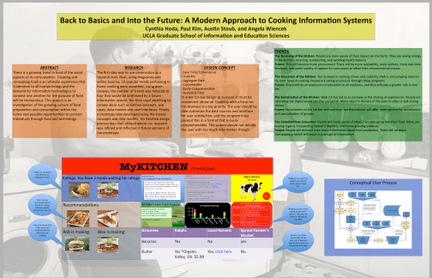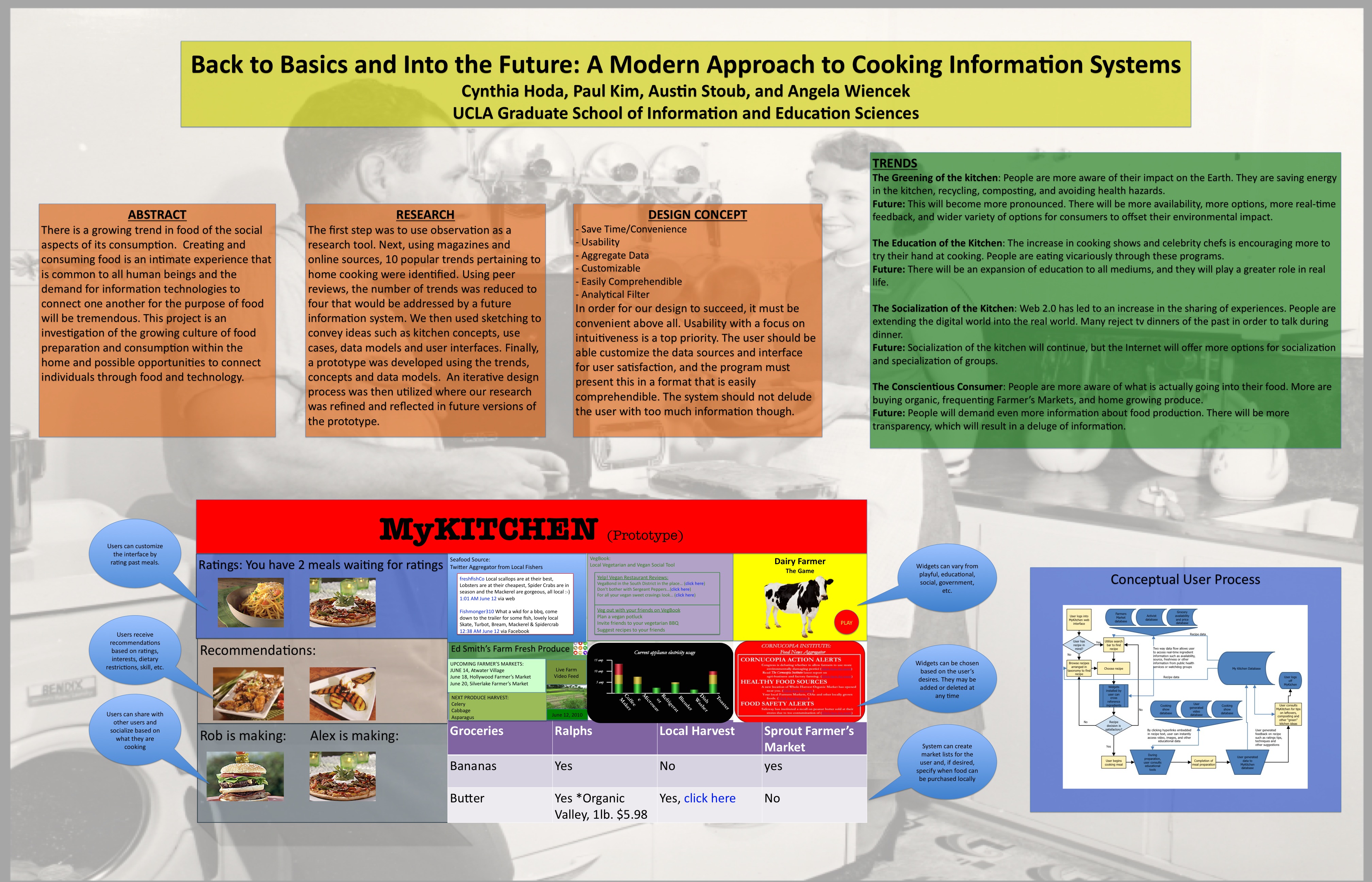myKitchen
Project Team: Cynthia Hoda, Angela Wiencek, Paul Kim, Austin Stoub
(click on image to enlarge)
Abstract:
There is a growing trend in food on the social aspects of its consumption. Creating and consuming food is an intimate experience that is common to all human beings and the demand for information technologies to connect one another for the purpose of food will be tremendous. This project is an investigation of the growing culture of food preparation and consumption within the home and possible opportunities to connect individuals through food and technology.
INTRODUCTION
Trends that a food information system will have to address are the role of the kitchen as a social nexus, conscientious food selection and preparation, greening of the kitchen and home cooking education. Behind each of these trends is a growing wealth of data that is slowly becoming unmanageable with current tools. For example, as part of conscientious food selections, consumers want FDA data on the amount of pesticides on this year’s corn from Iowa.1 This information is difficult to obtain by the average users. As a result, the goal of the project will not only be to create an information system that will manage and organize this data, but also create a framework or “ecosystem” to facilitate the connection between information seekers and information providers. Furthermore, this information system will link the users with each other for the purposes of food and information sharing.
Approach
The first step in the approach was to use observation as a research tool or ethnography. As part of our design process, we looked into the home cooking group’s cooking habits and found great disparities in cooking activities; some in our group preferred planned out meals, producing menus and grocery lists, while others made last minute decisions hours our minutes before meals. This insight drove us to a design that would be flexible and customizable, meeting the user at their needs and expectations.
Next, using magazines and online sources, 10 popular trends pertaining to food production and consumptions were identified. Using peer reviews the numbers of trends were eventually reduced down to four main trends that would need to be addressed by a future information system.
Sketching was also a critical component of the design process as pen and paper were used to convey ideas such as kitchen concepts, use cases, data models and user interfaces.
Finally, a prototype was developed using the trends, concepts and data models created. After the prototype was created an iterative design process was utilized where the concepts, trends and data models were further refined and reflected in future versions of the prototype.
Trends
Socialization of the Kitchen
The trend of socialization of the kitchen revolves around the fact that individuals wish to share the experience of creating and eating food.2 Some of this drives from the belief that family and eating food together can strengthen community bonds. This desire to share food and food information has extended into the digital ream through the Internet. The Internet has made sharing and coordinating meals and meal information easier. For example, food blogs and albums are a growing segment of Web 2.0 applications.3 Soon, keeping track of which recipes to try, meal events to attend and meals to plan will become overwhelming. To compensate for this data deluge, people may consciously try to build social networks based on food and plan meals, and the desire to manage these networks will be a future need.
Greening of the Kitchen
Society is becoming more environmentally conscious and the kitchen is no exception. Some of the issues include power consumption, recycling, composting and eliminating waste.4 Although there are best practices that exist for each of these issues, consumers may not have this information readily available. Furthermore, these best practices may not be comparable and their impact may not be apparent. As a result, the future for this trend will be to know which best practices fit best for the user and provide maximum benefit to the environment.
Conscientious Food Preparation
As society has industrialized and taken a mass production approach to food preparation, consumers have become more detached to the actual production of food.5 Currently as consumers are reeducated on how food is mass produced, they are demanding more information on the nutritional and environmental aspects of their food.6 Furthermore, consumers want to know other options for obtaining food with the desired set of characteristics that they want such as shopping at farmer’s markets and growing a vegetable garden. As a result people will demand more information and transparency on food production which will result in a deluge of information.
Home Cooking Education
The rise of the celebrity chef, cooking and eating competitions and food tourism are all indications that people are seeking to know more about how to prepare food themselves.7 Some of the education that is occurring right now include YouTube cooking channels, food based TV, applications and software to assist with food preparation. Currently all of these mediums for food education are separated in the future will see an integration of these mediums tailored to the user.
Data Modeling
There are two main data modeling products that were produced to support the development of the design. First, an entity-relationship diagram was developed to identify which interfaces and data definitions needed to be developed to implement the system. The ERD centers on the myKitchen application which interfaces with the user, external data sources, recipe sources, other myKitchen applications and 3rd party developers. The second product is the process diagram. For this model, we imagined how a user, one of the group or an outside individual, might customize and interact with the interface. We paid careful attention to what trends might influence various users and how our system might be able to respond to meet their needs. Allowing user control at every juncture of the process was a central theme in our design process.
Prototype
The prototype is a mock up of the user interface of the myKitchen application. There are six main components to the myKitchen application which is the search engine, recommended recipes, recipe rater, recipe history, selected/planned recipes and widget area. The recommended recipes are simply a row of recipes that have been generated based on prior selection and search parameters. The search engine will either search the recipe database directly based purely on the search parameters or it will search based on user prior selection and/or user parameters. The selected/planned recipe(s) is another row that consists of selected recipes by the user. The recipe rater is another row that allows the rating of each completed recipe which feeds into the user preferences and user history. When the mouse rolls over a recipe, a matrix of ingredients vs markets will appear so that the user can decide where to get the ingredients from the markets that have the ingredients with the attributes that he or she desires. The widget area is what provides the most flexibility in the system by allowing 3rd party developers to develop widgets that would allow information, videos, and other applications to be available to the user to make food and recipe decisions. The widget framework will also allow the user to flexibly choose how he or she will incorporate the trends of socialization of the kitchen, greening of the kitchen, conscientious food preparation and home cooking education. For example, if a user is interested in obtaining information on how to lower one’s carbon footprint and at the same time learn how to cook like Iron Chef Morimoto, the user could incorporate those widgets in his or her widget area to accomplish the user’s goals. Creating this flexibility was critical since human behavior is next to impossible to predict. As a result, it was decided that the customization of the myKitchen application be driven by demand from the users on what information they desired and 3rd party developers satisfying that information need.
References
1. United Stated Food and Drug Adminstration, “Pesticide Monitoring Program FY 2007,” http://www.fda.gov/Food/FoodSafety/FoodContaminantsAdulteration/Pesticides/ResidueMonitoringReports/ucm169577.htm, accessed May 23, 2010.
2. Amy Hoak, “Consumers Stary at Home More and Housewares Industry Takes Note,” MarketWatch, Mar. 27, 2009: http://www.marketwatch.com/story/the-five-top-trends-well-see, accessed May 21, 2010.
3. “Foodista Blog,” Foodista: The Cooking Encyclopedia Everyone can Edit: http://www.foodista.com/blog/, accessed May, 23, 2010.
4. Lila Guterman, “Eco-Friendly in the Kitchen,” Washington Post, Sept 17, 2005, http://www.washingtonpost.com/wp-dyn/content/article/2005/09/16/AR2005091600975.html, accessed May 25, 2010.
5. “Whole Foods Philsophy,” Simple Social Kitchen, http://www.simplesocialkitchen.com/about/whole-foods-philosophy/, accessed May 22, 2010.
6. “Deconstructing Dinner,” Kootenay Co-Op Radio, http://www.cjly.net/deconstructingdinner/081607.htm, accessed May 21, 2010.
7. Gary Levin, “Food Shows are Whipping TV Networks into a Frenzy,” USAToday, Dec. 24, 2009: http://www.usatoday.com/life/television/news/2009-12-24-foodTV24_ST_N.htm, accessed May 24, 2010.